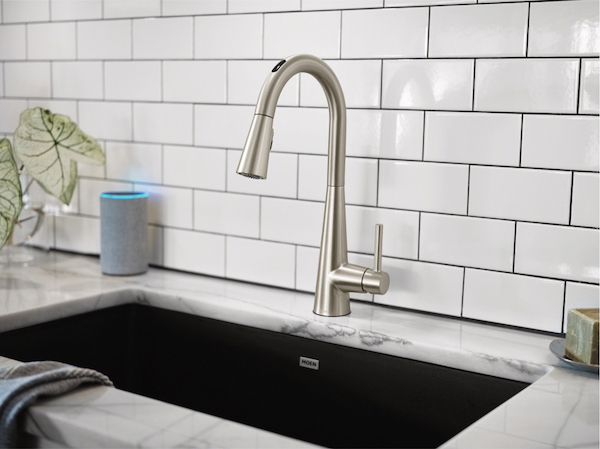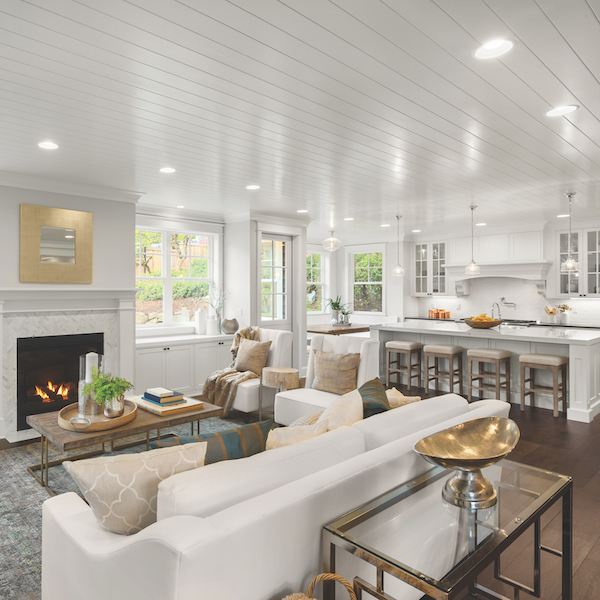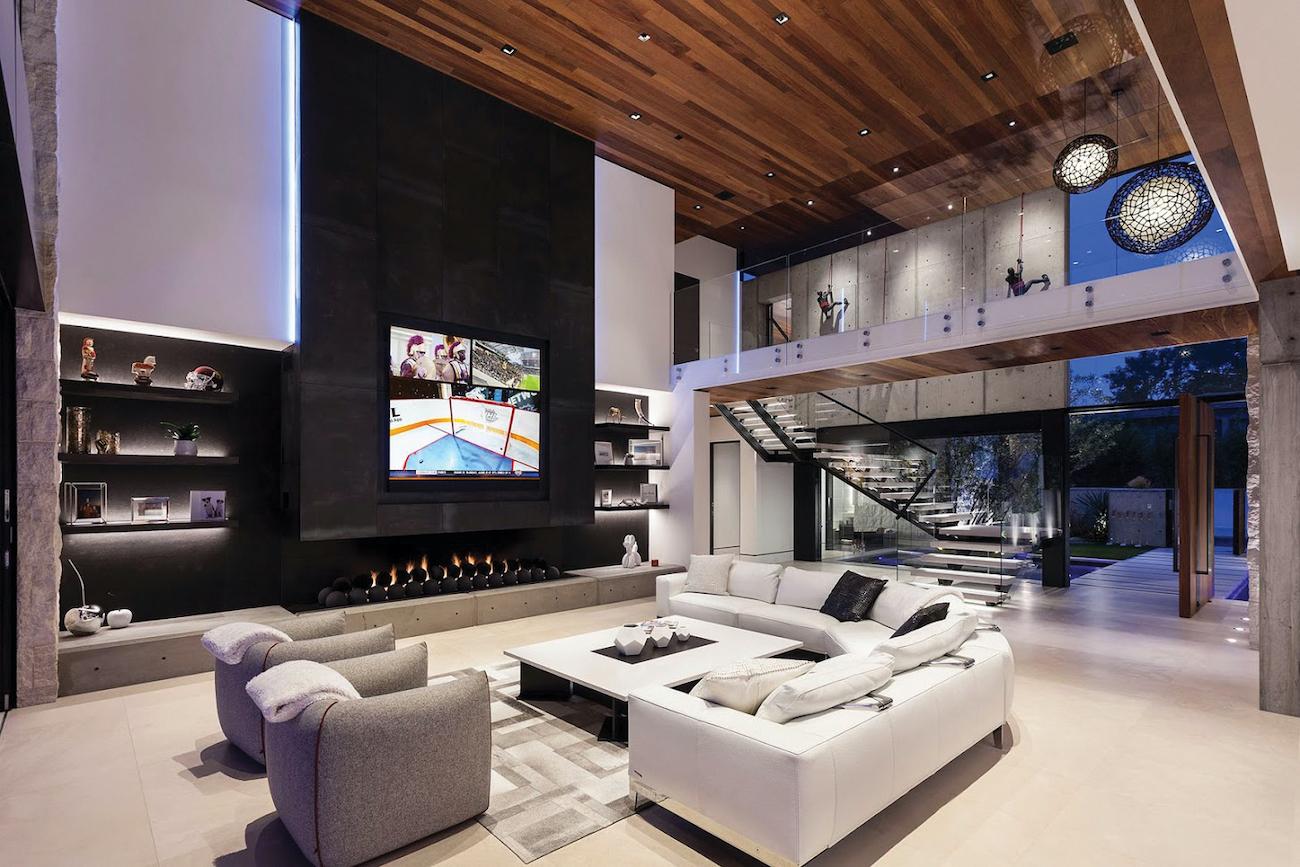At one time, smart home systems were only found in ultra-high-end luxury design projects. Their complexity and high price tags made them unattainable for the average homeowner. Times have since changed. A study by Mordor Intelligence estimates that one in six Americans owns a smart speaker, and says the smart home market is set to reach a value of more than $313 billion by 2023. The technology is now more affordable and systems with heaps of functionality can be easily installed by most homeowners, while the market for high-end luxury systems still exists.

This spectrum of system sizes, costs and abilities leaves opportunities for retailers and designers to reap the benefits of smart home products. From appliances to security to HVAC controls, smart and connected home features can be found in every room of the home. For designers and retailers, smart lighting systems can play a huge role in the overall home design.
Onboarding
The terms “smart” and “connected,” mean almost the same thing, according to Peter Romaniello, IALD, Owner of Conceptual Lighting, a lighting design firm based in Huntersville, NC. The most basic form of a smart lighting system is an outdoor light on a timer, set to turn a light on and off at certain times. When voice control or Bluetooth enter the picture, then a system is also considered connected, he says.
Romaniello says consumers who consider these systems first have to consider their perceived value. This perceived value goes beyond the typical homeowner concerns — turning on the kitchen lights with voice control when walking in with an armful of groceries, or lighting the way to the bathroom in the middle of the night. For these convenience factors, a simpler DIY system might be the best approach.
But as the perceived value increases, so does the complexity of the systems. More complex systems or systems installed in larger homes likely require the help of
a professional.
“As the cost of the project goes up, the expectation level of the technology also goes up and, because the cost goes up, you also have theoretically higher cost per square foot,” Romaniello says. “So when the cost per square foot goes up, then there tends to be more funds available for things like a whole-house control system.”
Melvyn Kahn, Co-Owner of Lightstyles, says the teams at his three Orange County, CA, lighting showrooms can help customers find products for homes up to around 5,000 square feet. Anything larger than that, he says, requires someone with more technical skills than the average homeowner. Kahn notes that a well-designed smart lighting system has benefits in both aesthetics and functionality.
“I think the smart home today is more important than ever before,” he says. “Not only because we have so much advanced technology at hand, but also because we use space differently today than we did 20 years ago.”
As an example, Kahn says kitchens are no longer a place used solely for cooking. They’re more open spaces than they once were, and provide a space for gathering, working and entertaining as they often bleed into the living space.

“I think the key to any good design for any space is understanding that space has to be layered in accordance to the function of that particular space,” Kahn says. “This is where smart lighting comes into it, because you may want to do some accent things like toe kick lighting, under cabinet lighting or recessed lighting, pendants over an island. There are all these different layers that have to operate in concert with one another. Functionally, sometimes one has dependency on certain layers more so than at other times, so we need the flexibility.”
Rather than fill the wall with switches — an affliction Kahn calls “wall acne” — smart lighting controls help streamline the lighting design.
Lighting manufacturer Satco recently entered the smart lighting category with the launch of the Starfish smart lighting system.
“The voice control was the pivotal piece for us and our reason for waiting to enter into that space,” says Brian Brandes, SVP of Product Development and Marketing for Satco. “Smart lighting has been around for years and we’ve watched the category grow. We’ve kept looking into it, deciding where our entry point would be.”
The Starfish product is on the consumer end of the spectrum, offering easy installation and integration with smart home devices like the Amazon Alexa and Google Home. The line includes smart light bulbs, tape lights and electrical components to create a connected system of devices that can work in tandem with other linked devices in the home, such as thermostats or security devices. For example, the homeowner can program the system to turn a light on if someone rings a doorbell linked to the system, or sync the lighting to their music.
The DIY Approach
For the out-of-the-box smart lighting systems that a homeowner can install, lighting showrooms are huge assets, both during the sales process and after.
“The first thing that a lighting retailer has to do is to answer the question of, are they selling a product and expecting the homeowner to program it, or are they selling a product and providing some sort of in-home service to program and troubleshoot that product?” Romaniello says. If a customer makes a purchase, gets home and can’t figure out how to use it, they will return it if they don’t have the showroom’s support to help resolve issues.
One obstacle with DIY systems arises when the homeowner purchases a system online without the guidance of a knowledgeable lighting showroom. Today’s lighting systems are specialized, but educated showroom employees can help customers pair the correct controls with the products.
“Our team will always make sure that we are specifying the right dimmer control for the product that they want to control,” Kahn says. “Whether it’s a product that we have sold them or they’d be buying from us, or a product that they’ve already bought elsewhere, it’s not a problem because we are helping them with choosing the right system. Our team will look up the specifications of that particular light to make sure that they are being sold the product that is going to work for that dimming protocol.”
It is for this reason that showroom staff should be up to speed on the latest technologies. At Lightstyles, staff regularly attends manufacturer training sessions to stay on top of new product developments.
“We will not carry a system here unless it is a recognized brand name that has training and support,” Kahn says. “And it’s imperative that if we want to be distributors for this that we understand it. All our associates are fully trained. It’s not a question of saying, ‘I’ll let you speak to so-and-so because they know more about it than I do.’ We make sure that all our people are fully versed with everything.”
On the manufacturer side, Satco sales representatives and internal staff underwent extensive training prior to the Starfish product launch. This knowledge can then be passed onto the showrooms. The company offers end-user support as well.
“In each one of our locations we have what we refer to as a ‘super user’ or an expert that has been part of the onboarding of this product process,” Brandes says. “We’ve kept them engaged and educated on every step,
and everybody that we trained within the company is totally up to speed on the technology.”
For more complicated specification-grade smart home systems, design and installation should be left to experts. For most interior designers, this means bringing in lighting designers, electricians and audio/visual specialists to ensure the system is designed and installed correctly.
Romaniello says designers should make it a point to learn the capabilities of these lighting control systems, but know their limitations. Still, in 2021, he says there’s a responsibility for designers to broach the topic of controls.
“If an interior designer happens to be doing a lighting plan with their client and they’re not talking about how they’re going to be turning it on and off, then they’re doing a disservice to their client,” Romaniello says. “And if they’re doing that because they don’t know any better, then they should get somebody involved who does know better.”
Making a Case
While this technology has been more readily adopted by clients and customers, there still can be reservations. Awareness and education can
go a long way in demonstrating the benefits of smart home systems, particularly with lighting.
“When we looked at the marketing of it, we defined connection, security, atmosphere, convenience and wellness as being the key factors in how we are marketing and positioning the product,” Brandes says. “It does all those things. If the user is taking full advantage of what the product can do, then there are so many things that you can do from a creative perspective of how it engages your life and throughout your day.”
Kahn notes that many homeowners he sees are still reluctant to adopt the technology, which usually stems from a fear that it will be too complex or unnecessary. He believes smart lighting systems will only gain popularity as consumers are more educated about their capabilities. The average homeowner doesn’t need to know about dimming protocols; they just need to know that the smart options available to them will make their lives easier — the trips to the bathroom in the dark, the feeling of security turning on outdoor lights at night or the mood lighting for entertaining.
“When they see how easy it is, they come back and say, ‘I think I’m going to get another couple of switches for my kitchen,’” he says. “And if you track that customer, you’ll find that within a matter of a few months they’ve bought a whole system for their whole house because they’re comfortable. People are scared of the unknown, and when they see how simple and easy it is they embrace it. And when they do, they like it so much that they can’t get enough of it.”







